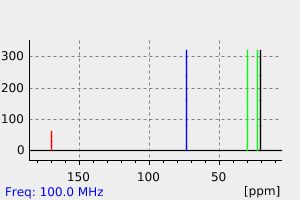(1R,2R)-反式-1,2-环己二醇二乙酸酯 | 130464-07-2
中文名称
(1R,2R)-反式-1,2-环己二醇二乙酸酯
中文别名
——
英文名称
(R,R)-1,2-diacetoxycyclohexane
英文别名
trans-1,2-Diacetoxy-cyclohexan;cis-1,2-Cyclohexanediol diacetate;[(1R,2R)-2-acetyloxycyclohexyl] acetate
CAS
130464-07-2
化学式
C10H16O4
mdl
——
分子量
200.235
InChiKey
NSTPWRQTPXJRSP-NXEZZACHSA-N
BEILSTEIN
——
EINECS
——
-
物化性质
-
计算性质
-
ADMET
-
安全信息
-
SDS
-
制备方法与用途
-
上下游信息
-
文献信息
-
表征谱图
-
同类化合物
-
相关功能分类
-
相关结构分类
物化性质
-
熔点:57-59 °C
-
沸点:249.7±33.0 °C(Predicted)
-
密度:1.09±0.1 g/cm3(Predicted)
计算性质
-
辛醇/水分配系数(LogP):1.3
-
重原子数:14
-
可旋转键数:4
-
环数:1.0
-
sp3杂化的碳原子比例:0.8
-
拓扑面积:52.6
-
氢给体数:0
-
氢受体数:4
SDS
上下游信息
反应信息
-
作为反应物:描述:(1R,2R)-反式-1,2-环己二醇二乙酸酯 在 pseudomonas fluorescens lipase 作用下, 反应 6.0h, 以33%的产率得到trans-2-acetoxy-1-cyclohexanol参考文献:名称:对荧光假单胞菌脂肪酶催化的环状乙酸酯的对映选择性水解的见解摘要:用荧光假单胞菌脂肪酶(PFL)水解外消旋乙酸酯,得到具有R-构型的旋光性醇,与环的大小无关。提出了PFL催化水解的三点模型。DOI:10.1039/c39880000966
-
作为产物:描述:trans-1,2-cyclohexandiol 在 lipase AK 、 sodium carbonate 作用下, 以 乙酸乙酯 为溶剂, 反应 24.0h, 生成 (1R,2R)-反式-1,2-环己二醇二乙酸酯参考文献:名称:Kinetic resolution of trans-2-acetoxycycloalkan-1-ols by lipase-catalysed enantiomerically selective acylation摘要:Kinetic resolution of a series of racemic trans-cycloalkane-1.2-diol monoacetates rac-2a-d was performed by enantiomerically selective transesterification with vinyl acetate catalysed by commercial and our own-prepared fungal lipases to yield diacetates (R,R)-3a-d and monoacetates (S,S)-2a-d in high enantiomeric purity. The monoacetates (R,R)-2a-d were also prepared from the racemic diacetates rac-3a-d by lipase-catalysed hydrolysis. (C) 2003 Elsevier Ltd. All rights reserved.DOI:10.1016/s0957-4166(03)00568-8
文献信息
-
Enzymatic preparation of optically pure trans-1,2-cycloalkanediols作者:R. Seemayer、M. P. SchneiderDOI:10.1039/c39910000049日期:——trans-1,2-Cycloalkanediols (R,R)-1–4 and (S,S)-1–3 of high optical purities are prepared by enzymatic hydrolysis and esterification catalysed by a lipase from Pseudomonas sp. (SAM II).高光学纯度的反式-1,2-环烷二醇(R,R)-1–4和(S,S)-1–3是通过由假单胞菌(SAM II)催化的酶解和酯化反应制备的。
-
Adrenaline profiling of lipases and esterases with 1,2-diol and carbohydrate acetates作者:Denis Wahler、Olivier Boujard、Fabrice Lefèvre、Jean-Louis ReymondDOI:10.1016/j.tet.2003.11.059日期:2004.1The adrenaline test for enzymes is a general back-titration procedure to detect 1,2-diols, 1,2-aminoalcohols and alpha-hydroxyketones reaction products of enzyme catalysis by colorimetry. The method was used to profile a series of esterases and lipases for their esterolytic activity on a series of carbohydrate and polyol acetates. Substrates were prepared by peracetylation and used for parallel microtiter-plate analysis of enzyme activities. This method can be used to achieve a rapid and automated characterization of a set of enzymes during HTS screening. (C) 2003 Elsevier Ltd. All rights reserved.
-
Laine, Dramane; Fujita, Morifumi; Ley, Steven V., Journal of the Chemical Society. Perkin transactions I, 1999, # 12, p. 1639 - 1645作者:Laine, Dramane、Fujita, Morifumi、Ley, Steven V.DOI:——日期:——
-
Enantioselective acylation of alcohols catalyzed by lipase QL from Alcaligenes sp.: A predictive active site model for lipase QL to identify the faster reacting enantiomer of an alcohol in this acylation作者:Koichiro Naemura、Masaki Murata、Rie Tanaka、Masashi Yano、Keiji Hirose、Yoshito TobeDOI:10.1016/0957-4166(96)00186-3日期:1996.6Lipase QL-catalyzed acylation of secondary alcohols using isopropenyl acetate as the acylating agent in diisopropyl ether gave preferentially the corresponding acetate with an R configuration. On the basis of the results, a predictive active site model for lipase QL is proposed for identifying which enantiomer of a secondary alcohol reacts faster in this reaction. (C) 1996 Elsevier Science Ltd
-
Enantioselective acylation of primary and secondary alcohols catalyzed by lipase QL from Alcaligenes sp.: A predictive active site model for lipase QL to identify which enantiomer of an alcohol reacts faster in this acylation作者:Koichiro Naemura、Masaki Murata、Rie Tanaka、Masashi Yano、Keiji Hirose、Yoshito TobeDOI:10.1016/0957-4166(96)00429-6日期:1996.11Lipase QL (from Alcaligenes sp.)-catalyzed acylation of alcohols using isopropenyl acetate as the acylating agent in diisopropyl ether converted preferentially primary alcohols with an S configuration and secondary alcohols with an R configuration into the corresponding homochiral acetates. On the basis of observed enantiomer selectivities, a predictive active site model for lipase QL is proposed for identifying which enantiomer of a primary or a secondary alcohol reacts faster in this acylation. Copyright (C) 1996 Published by Elsevier Science Ltd
表征谱图
-
氢谱1HNMR
-
质谱MS
-
碳谱13CNMR
-
红外IR
-
拉曼Raman
-
峰位数据
-
峰位匹配
-
表征信息
同类化合物
(甲基3-(二甲基氨基)-2-苯基-2H-azirene-2-羧酸乙酯)
(±)-盐酸氯吡格雷
(±)-丙酰肉碱氯化物
(d(CH2)51,Tyr(Me)2,Arg8)-血管加压素
(S)-(+)-α-氨基-4-羧基-2-甲基苯乙酸
(S)-阿拉考特盐酸盐
(S)-赖诺普利-d5钠
(S)-2-氨基-5-氧代己酸,氢溴酸盐
(S)-2-[[[(1R,2R)-2-[[[3,5-双(叔丁基)-2-羟基苯基]亚甲基]氨基]环己基]硫脲基]-N-苄基-N,3,3-三甲基丁酰胺
(S)-2-[3-[(1R,2R)-2-(二丙基氨基)环己基]硫脲基]-N-异丙基-3,3-二甲基丁酰胺
(S)-1-(4-氨基氧基乙酰胺基苄基)乙二胺四乙酸
(S)-1-[N-[3-苯基-1-[(苯基甲氧基)羰基]丙基]-L-丙氨酰基]-L-脯氨酸
(R)-乙基N-甲酰基-N-(1-苯乙基)甘氨酸
(R)-丙酰肉碱-d3氯化物
(R)-4-N-Cbz-哌嗪-2-甲酸甲酯
(R)-3-氨基-2-苄基丙酸盐酸盐
(R)-1-(3-溴-2-甲基-1-氧丙基)-L-脯氨酸
(N-[(苄氧基)羰基]丙氨酰-N〜5〜-(diaminomethylidene)鸟氨酸)
(6-氯-2-吲哚基甲基)乙酰氨基丙二酸二乙酯
(4R)-N-亚硝基噻唑烷-4-羧酸
(3R)-1-噻-4-氮杂螺[4.4]壬烷-3-羧酸
(3-硝基-1H-1,2,4-三唑-1-基)乙酸乙酯
(2S,4R)-Boc-4-环己基-吡咯烷-2-羧酸
(2S,3S,5S)-2-氨基-3-羟基-1,6-二苯己烷-5-N-氨基甲酰基-L-缬氨酸
(2S,3S)-3-((S)-1-((1-(4-氟苯基)-1H-1,2,3-三唑-4-基)-甲基氨基)-1-氧-3-(噻唑-4-基)丙-2-基氨基甲酰基)-环氧乙烷-2-羧酸
(2S)-2,6-二氨基-N-[4-(5-氟-1,3-苯并噻唑-2-基)-2-甲基苯基]己酰胺二盐酸盐
(2S)-2-氨基-N,3,3-三甲基-N-(苯甲基)丁酰胺
(2S)-2-氨基-3-甲基-N-2-吡啶基丁酰胺
(2S)-2-氨基-3,3-二甲基-N-(苯基甲基)丁酰胺,
(2S)-2-氨基-3,3-二甲基-N-2-吡啶基丁酰胺
(2S,4R)-1-((S)-2-氨基-3,3-二甲基丁酰基)-4-羟基-N-(4-(4-甲基噻唑-5-基)苄基)吡咯烷-2-甲酰胺盐酸盐
(2R,3'S)苯那普利叔丁基酯d5
(2R)-2-氨基-3,3-二甲基-N-(苯甲基)丁酰胺
(2-氯丙烯基)草酰氯
(1S,3S,5S)-2-Boc-2-氮杂双环[3.1.0]己烷-3-羧酸
(1R,5R,6R)-5-(1-乙基丙氧基)-7-氧杂双环[4.1.0]庚-3-烯-3-羧酸乙基酯
(1R,4R,5S,6R)-4-氨基-2-氧杂双环[3.1.0]己烷-4,6-二羧酸
齐特巴坦
齐德巴坦钠盐
齐墩果-12-烯-28-酸,2,3-二羟基-,苯基甲基酯,(2a,3a)-
齐墩果-12-烯-28-酸,2,3-二羟基-,羧基甲基酯,(2a,3b)-(9CI)
黄酮-8-乙酸二甲氨基乙基酯
黄荧菌素
黄体生成激素释放激素(1-6)
黄体生成激素释放激素 (1-5) 酰肼
黄体瑞林
麦醇溶蛋白
麦角硫因
麦芽聚糖六乙酸酯
麦根酸







